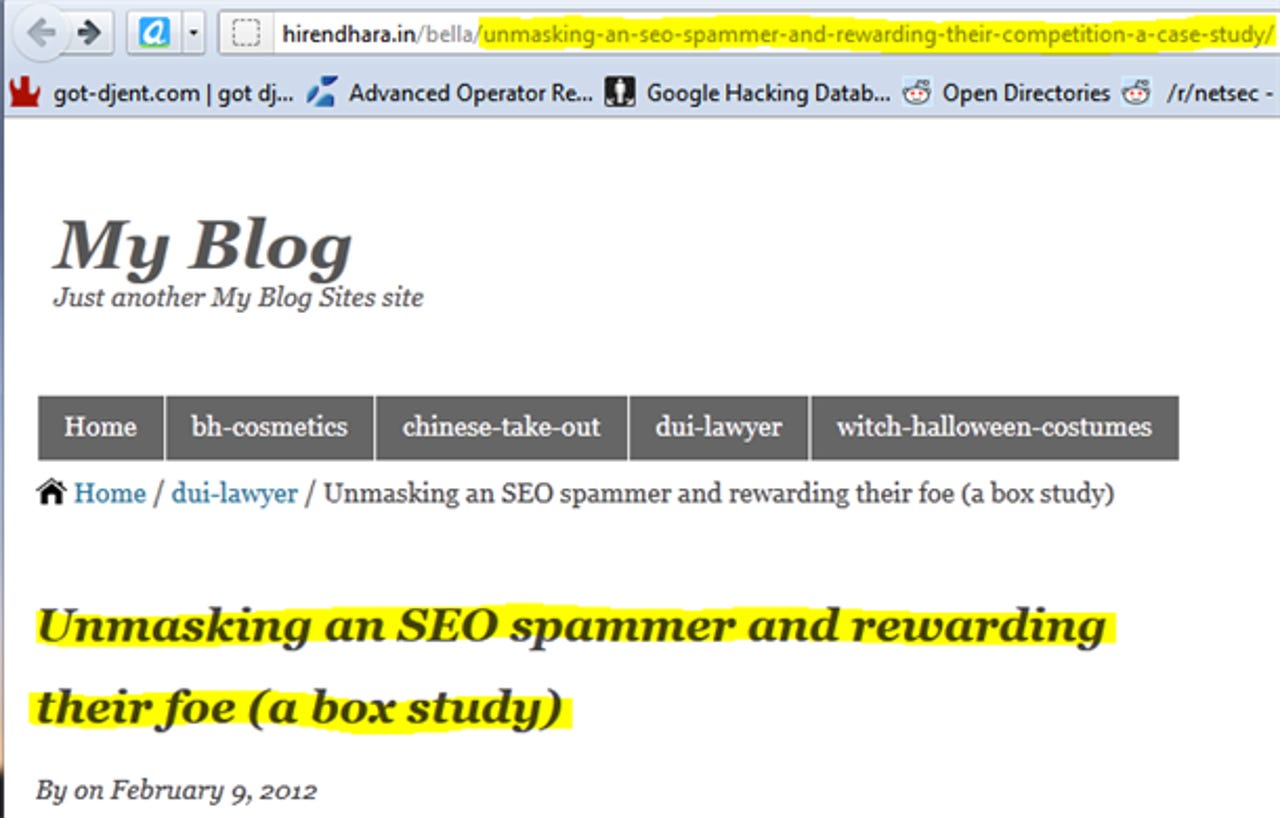Unmasking an SEO spammer and rewarding their foe (a box study)

If you thought the title of this post read a bit odd -- perhaps even a bit familiar, if you keep up with my posts -- you would be correct. Recently, I wrote a post titled "Unmasking an SEO spammer and rewarding their competition (a case study)," and it has made the rounds... sort of.
Because I included a link to a post on my old Microsoft blog, I sometimes receive notifications via email about it. Basically, there's a setting in certain CMSs (Content Management Systems) like WordPress that, whenever you link to an outbound site in a post of your own, attempts to contact that outbound site and say, "Hey! You just got linked to from this site!" They're called pingbacks and trackbacks. For my old Microsoft blog, I receive an email every time a pingback/trackback is sent.
All that to say, if you're going to scrape someone's content, spin it, and steal it, at least disable your pingbacks and trackbacks. I mean, that's just spam noob 101! And for those of you thinking I'm helping people spam, not quite. If you care about finding all the places your content is being thieved, there are certain Google queries you can run to find what your looking for.
For instance, search for the first 4-5 words in your post title, in quotes, and negate results from your own site. Most scrapers keep your same title and everything. For instance, using my "Unmasking an SEO spammer" post, here's a Google query I would run to find copied/scraped versions: intitle:"Unmasking an SEO spammer" | inurl:"Unmasking an SEO spammer" -inurl:zdnet.com
To note, not every result there is spam or scraped content. Just look for results that have copied your entire article. Back to this spammer that spun my article, take a look at this screen shot that I pulled from their site and notice what I highlighted:

Spammer version:
To start a adventure, I’d like to start by observant that some-more and more, we grow extremely sleepy of SEOs and/or companies who rivet in shameless spamming to boost rankings. The latest valuables popped adult in my email inbox recently and it immediately tweaked me a wrong way. On my Microsoft blog (which I’ve admittedly given no courtesy to over a past year), we perceived the following comment on a post from good over a year ago (never mind a fact that my comments are nofollow and a couple extract from that page is among a lowest on a site):
Original version:
To begin our adventure, I’d like to start by saying that more and more, I grow extremely tired of SEOs and/or companies who engage in shameless spamming to increase rankings. The latest jewel popped up in my email inbox recently and it immediately tweaked me the wrong way. On my Microsoft blog (which I’ve admittedly given no attention to over the past year), I received the following comment on a post from well over a year ago (never mind the fact that my comments are nofollow and the link juice from that page is among the lowest on the site):
For as comical as that is, in the end, content isn't spun with the intention of being read by people; it's spun with the intention of being crawled by search engines in attempts to help a site rank higher. And this is case in point for why I think Google (and other search engines) should be manually involved with the SERPs to some extent. I know that the Panda updates are there to combat sites like this from ranking higher than original content, but sites like this should be removed COMPLETELY instead of being allowed to take up ~87,000 results in the index... or so I feel, at least.
As a blogger, you just haven't "made it" until you've had a spammer scrape/steal your content and spin it! Yes, it is frustrating the first 101 or so times you have it happen to you, but at about 102/103, it ends up being more humorous than anything else. I mean, what better comedic gold than a spammer scraping an article about an SEO spammer, and then spinning it on their spammy site? Then again, maybe I'm just a big nerd for finding that funny, who knows? :)
To close, I'd like to repeat what I said at the end of my "Unmasking an SEO spammer" post: Thanks for reading my case study, and remember: DON’T BE A SPAMMER!
And now, the spammy, spun version: Thanks for reading my box study, and remember: DON’T BE A SPAMMER! "Box study," hahaha. Makes me laugh every time!